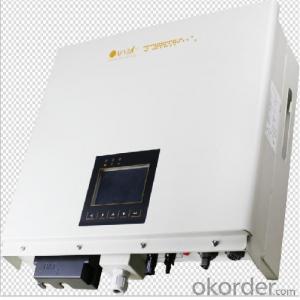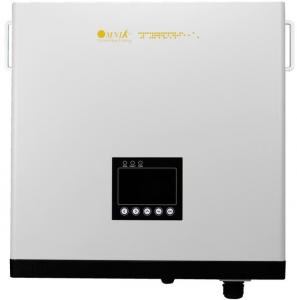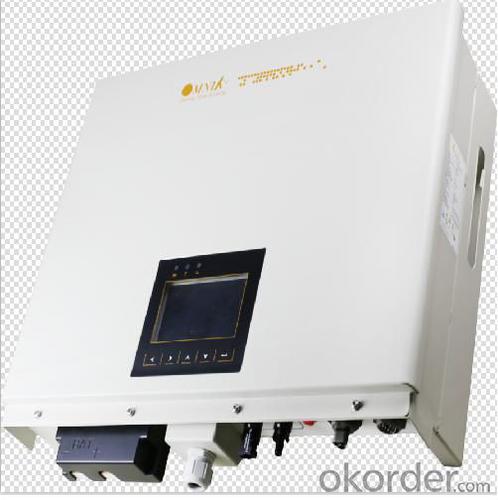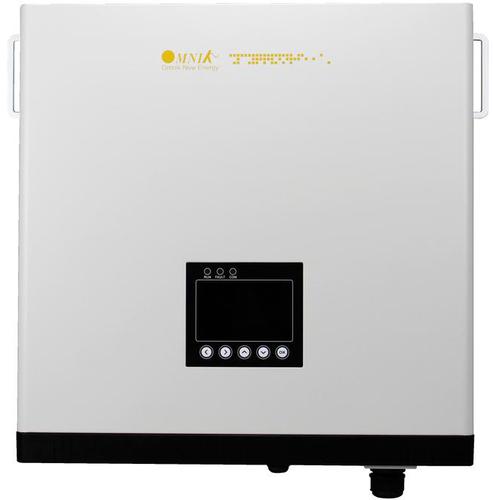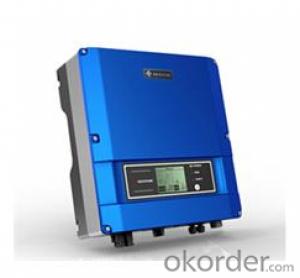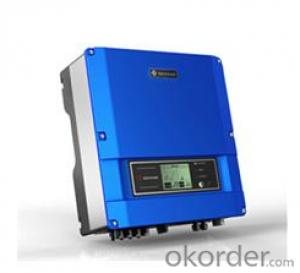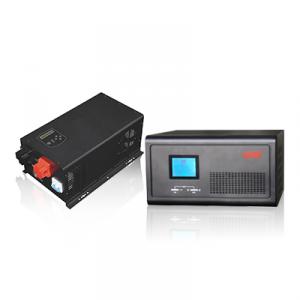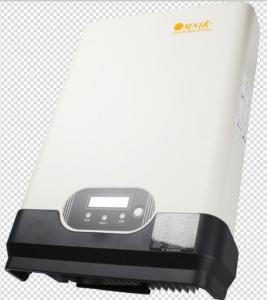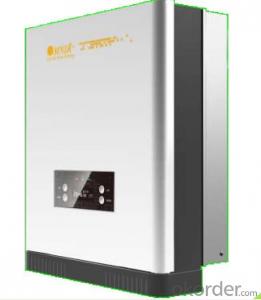On grid solar inverter Omniksol-20k-TL Three phase
- Loading Port:
- Shanghai
- Payment Terms:
- TT OR LC
- Min Order Qty:
- 1 pc
- Supply Capability:
- 3000 pc/month
OKorder Service Pledge
OKorder Financial Service
You Might Also Like
Omnik new energy solar inverter
Omniksol-2.0k-TL Photon Efficiency up to 3kW
in the world------ Photon tested Jan. 2012.
Omniksol-20k-TL
1.Futures
Max. Efficiency 98.2%, Euro. Efficiency 97.8%.
Double MPPT, MPPT accuracy up to 99.9%.
IP65 design, work properly under severe outdoor circumstances.
Full solution of safety protection, DC switch integrated.
Flexible input and output connections, support RS485, Ethernet
and USB communication.
Transformerless design and high power density, lighter and more
convenient for installation.
2.Technical data:
Type | Omniksol-13k-TL | Omniksol-17k-TL | Omniksol-20k-TL |
Max. PV-Generator Power [W] | 13500 | 17600 | 21200 |
Max. DC voltage [V] | 1000 | 1000 | 1000 |
MPPT DC voltage Range [V] | 400-800 | 440-850 | 440-850 |
Turn off DC voltage [V] | 640 | 640 | 640 |
Max. DC Current [A] | 22/11 | 22/22 | 22/22 |
Nominal DC Current [A] | 28 | 33 | 33 |
Number of DC Connection | 2 | 2 | 2 |
DC-Connection | MC4 | MC4 | MC4 |
Number of MPP trackers Turn on Power [W] | 2 | 2 | 2 |
3. Product certificate
EN 61000
VDE 0126-1-1
C10/11
G83/2
UTE C15-712-1
AS4777
CQC
CE10-21
EN50438
4.product outlook
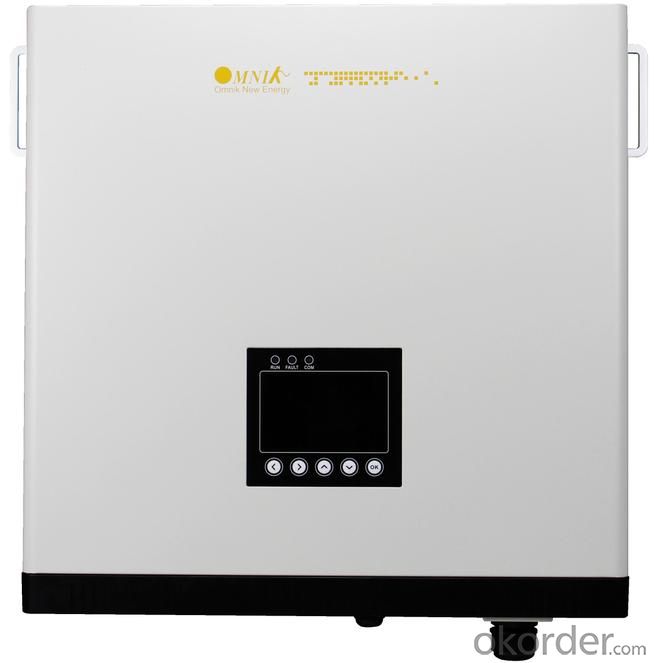
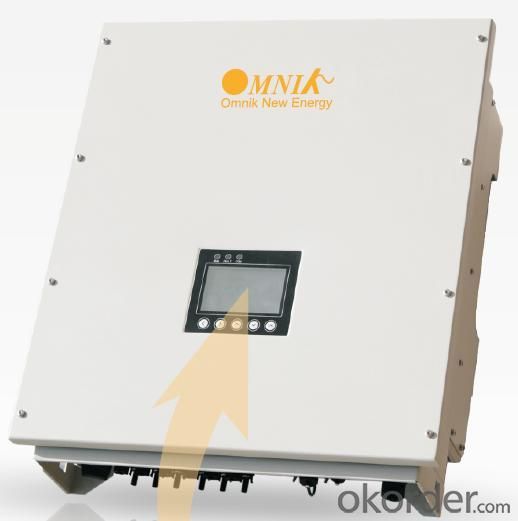
FAQ
1. What price for each watt?
It depends on the efficiency of the solar cell, quantity, and delivery date and payment terms.
2. How long can we receive the product after purchase?
In the purchase of product within three working days, We will arrange the factory delivery as soon as possible. The pacific time of receiving is related to the state and position of customers. Commonly 7 to 10 working days can be served.
We can provide you not only the solar material but also the off grid solar system, we can also provide you service with on grid plant.
4. How do you pack your products?
We have rich experience on how to pack the solar cell to make sure the safety on shipment; we could use wooden box or pallet as buyer's preference.
5. Can you do OEM for us?
Yes, we can.
- Q: Can a solar inverter be used in systems with different module capacities?
- Yes, a solar inverter can be used in systems with different module capacities. Solar inverters are designed to convert the DC power generated by solar modules into AC power for use in homes or businesses. They are typically flexible and compatible with a wide range of module capacities, allowing them to be used in systems with varying sizes and configurations. However, it is important to ensure that the inverter's capacity matches or exceeds the total capacity of the connected solar modules to ensure optimal performance and efficiency.
- Q: What is the role of a power limiter in a solar inverter system?
- The primary function of a power limiter in a solar inverter system is to regulate the amount of power that is supplied to the grid from the solar panels. When the solar panels produce more power than necessary or permitted by the grid, the power limiter serves as a control mechanism to restrict the amount of power injected into the grid. This control mechanism ensures that the power output from the solar panels remains within the specified limits, preventing any overloading or destabilization of the grid. To achieve this, the power limiter continuously monitors the power output from the solar panels and adjusts it accordingly to meet the grid requirements. It achieves this by intelligently controlling the inverter, which converts the direct current (DC) generated by the solar panels into alternating current (AC) suitable for integration with the grid. By limiting the power fed into the grid, the power limiter plays a crucial role in maintaining the stability of the grid. It helps prevent voltage fluctuations, reduces the risk of power surges or blackouts, and ensures compliance with local regulations and grid codes pertaining to solar power generation. Furthermore, the power limiter can offer additional functionalities such as grid synchronization, anti-islanding protection, and remote monitoring. These additional features enhance the safety, reliability, and overall performance of the solar inverter system. In summary, the inclusion of a power limiter in a solar inverter system is essential for maintaining a balance between power generation and grid stability. It optimizes the use of solar energy and ensures the safe and efficient integration of solar power into the electrical grid.
- Q: What is the role of a solar inverter in preventing system failures?
- The role of a solar inverter in preventing system failures is to convert the direct current (DC) electricity generated by solar panels into alternating current (AC) electricity that can be used to power homes and businesses. In addition to this conversion, solar inverters also play a crucial role in ensuring the stability and efficiency of the entire solar power system. They monitor and regulate the voltage and frequency of the electricity being generated, protecting the system from overvoltage, undervoltage, and other electrical abnormalities that can potentially lead to system failures. By constantly monitoring and adjusting the electrical output, solar inverters help maintain the health and reliability of the solar power system, ultimately preventing potential failures and maximizing the overall performance.
- Q: How do you choose the right size solar inverter for your system?
- To choose the right size solar inverter for your system, you need to consider the total power output of your solar panels and the maximum power rating of the inverter. It is important to match the inverter's capacity with the maximum power output of your solar panels to ensure optimal performance and efficiency. Additionally, factors such as the type of system (off-grid or grid-tied) and future expansion plans should also be taken into account when determining the appropriate size of the solar inverter for your system.
- Q: What is the role of a solar inverter in a residential system?
- The role of a solar inverter in a residential system is to convert the direct current (DC) electricity generated by the solar panels into alternating current (AC) electricity that is suitable for use in the home. It also manages the flow of electricity, monitors the system's performance, and ensures safety by providing protection against electrical faults.
- Q: Can a solar inverter be used with a solar-powered disaster relief system?
- Yes, a solar inverter can be used with a solar-powered disaster relief system. A solar inverter is an essential component of a solar power system, converting the direct current (DC) generated by solar panels into alternating current (AC) that can be used to power electrical devices. In a disaster relief system, solar panels capture sunlight and convert it into electricity, which is then fed into the inverter to produce usable AC power for various relief operations such as lighting, charging devices, or running essential equipment. Thus, a solar inverter is crucial in enabling the functionality and effectiveness of a solar-powered disaster relief system.
- Q: What is the importance of voltage and frequency control in a solar inverter?
- Voltage and frequency control are crucial in a solar inverter as they ensure the stability and reliability of the electrical system. Voltage control regulates the output voltage of the inverter, ensuring it is within safe limits and compatible with the grid or the connected appliances. This is important to protect the electrical devices from overvoltage or undervoltage conditions, which could potentially damage them. Frequency control, on the other hand, maintains the output frequency of the inverter in synchronization with the grid frequency. This synchronization is vital for the seamless integration of the solar power into the existing electrical grid. Inconsistent frequencies can lead to instability, power quality issues, and potential damage to equipment. Overall, voltage and frequency control in a solar inverter play a significant role in maintaining a reliable and efficient electrical system, safeguarding the connected appliances, and ensuring the proper integration of solar power into the grid.
- Q: Can a solar inverter be used with a wireless communication system?
- Yes, a solar inverter can be used with a wireless communication system. In fact, many modern solar inverters are designed with built-in wireless communication capabilities to allow for monitoring and control of the system remotely. This enables users to access real-time data, adjust settings, and receive notifications about the performance of their solar power system through a wireless connection, such as Wi-Fi or cellular networks.
- Q: What is the role of a solar inverter in a grid-independent system?
- The role of a solar inverter in a grid-independent system is to convert the direct current (DC) electricity generated by solar panels into alternating current (AC) electricity that can be used to power household appliances and other electrical devices. It also regulates the voltage and frequency of the electricity to ensure compatibility with the electrical grid. In a grid-independent system, the solar inverter allows for the utilization of solar power without relying on the traditional power grid, enabling self-sufficiency and reducing dependence on fossil fuels.
- Q: How does a solar inverter handle partial shading on solar panels?
- A solar inverter handles partial shading on solar panels by utilizing a technique called Maximum Power Point Tracking (MPPT). MPPT allows the inverter to continuously track the optimal operating point of each individual solar panel, even if some panels are partially shaded. By constantly adjusting the voltage and current levels of the panels, the inverter ensures that the shaded panels do not significantly affect the overall system performance, maximizing the energy output of the entire solar array.
Send your message to us
On grid solar inverter Omniksol-20k-TL Three phase
- Loading Port:
- Shanghai
- Payment Terms:
- TT OR LC
- Min Order Qty:
- 1 pc
- Supply Capability:
- 3000 pc/month
OKorder Service Pledge
OKorder Financial Service
Similar products
Hot products
Hot Searches
Related keywords
